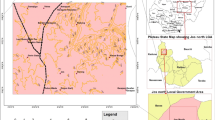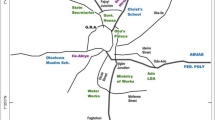Abstract
Remote sensing, evaluation of digital elevation models (DEM), geographic information systems (GIS) and fieldwork techniques were combined to study the groundwater conditions in Eritrea. Remote sensing data were interpreted to produce lithological and lineament maps. DEM was used for lineament and geomorphologic mapping. Field studies permitted the study of structures and correlated them with lineament interpretations. Hydrogeological setting of springs and wells were investigated in the field, from well logs and pumping test data. All thematic layers were integrated and analysed in a GIS. Results show that groundwater occurrence is controlled by lithology, structures and landforms. Highest yields occur in basaltic rocks and are due to primary and secondary porosities. High yielding wells and springs are often related to large lineaments, lineament intersections and corresponding structural features. In metamorphic and igneous intrusive rocks with rugged landforms, groundwater occurs mainly in drainage channels with valley fill deposits. Zones of very good groundwater potential are characteristic for basaltic layers overlying lateritized crystalline rocks, flat topography with dense lineaments and structurally controlled drainage channels with valley fill deposits. The overall results demonstrate that the use of remote sensing and GIS provide potentially powerful tools to study groundwater resources and design a suitable exploration plan.
Résumé
Télédétection, évaluation de modèles numériques de terrain (MNT), systèmes d’informations géographiques (SIG) et techniques de terrain ont été combinées pour étudier les eaux souterraines en Eritré. Les données de télédétection ont été interprétées pour la réalisation d’une carte lithologique et d’une carte des linéaments. Le MNT a été utilisé pour la cartographie des linéaments et de la géomorphologie. Les études de terrain ont permit d’étudier les structures et de les corréler avec l’interprétation des linéaments. Les sources et les puits ont été investigués sur le terrain, ainsi qu’à partir de log et d’essais de pompages. Toutes les couvertures thématiques ont été intégrées et analysées dans un SIG. Les résultats montrent que l’occurrence de l’eau souterraine est contrôlée par la lithologie, les structures et la forme des paysages. Les meilleurs débits se trouvent dans les roches basaltiques et sont dus aux porosités primaires et secondaires. Les puits et les sources possédant les meilleurs débits sont en relation avec les grands linéaments, les intersections de linéaments et leurs structures correspondantes. Dans les roches métamorphiques, intrusives et ignées, sous des paysages forts accidentés, l’eau souterraine apparaît essentiellement dans les chenaux de drainage des dépôts de fonds de vallée. Les zones présentant un excellent potentiel d’eau souterraine, sont caractéristiques des couches basaltiques recouvrant les roches cristallines latéritiques, les zones plates possédant un réseau dense de linéaments et structuralement contrôlées par les chenaux de drainage avec des dépôts de fond de vallée. Le résultat global démontre que l’utilisation de la télédétection et des SIGs procure des outils potentiellement puissants pour l’étude des ressources en eau souterraine et pour le montage de plans d’exploration convenables.
Resumen
Se combinó el uso de sensores remotos, la evaluación de modelos de elevación digitales (MED), sistemas de información geográfico (SIG), y técnicas de trabajo de campo para estudiar las condiciones del agua subterránea en Eritrea. Se interpretaron los datos de sensores remotos para producir mapas de lineamientos y litológicos. Los MED se usaron para el mapeo geomorfológico y de lineamientos. Los estudios de campo permitieron estudiar las estructuras y correlacionarlas con interpretaciones de lineamientos. Se investigó el marco hidrogeológico de manantiales y pozos en el campo a partir de registros de pozos y datos de pruebas de bombeo. Todas las capas temáticas se integraron y analizaron en un SIG. Los resultados muestran que la presencia de agua subterránea es controlada por litología, estructuras, y paisajes. Los rendimientos más altos ocurren en rocas basálticas y se deben a porosidades primarias y secundarias. Los pozos con altos rendimientos frecuentemente están relacionados con lineamientos grandes, intersecciones de lineamientos y sus características estructurales correspondientes. En rocas ígneas intrusivas y metamórficas con paisajes accidentados, el agua subterránea ocurre principalmente en canales de drenaje con depósitos de relleno en valles. Zonas con muy buen potencial de agua subterránea son características de capas basálticas que sobreyacen rocas cristalinas lateritizadas, topografía plana con lineamientos densos, y canales de drenaje con control estructural con depósitos de relleno de valle. Los resultados globales demuestran que el uso de sensores remotos y SIG aportan herramientas potencialmente poderosas para estudiar los recursos de agua subterránea y diseñar un plan exploratorio apropiado.









Similar content being viewed by others
References
Asgedom A (1998) Groundwater Assessment in the South Highlands of Eritrea using TM Images. M.Sc., University of New South Wales, Australia
Drury SA, Berhe SM (1993) Accretion tectonics in northern Eritrea revealed by remotely sensed imagery. Geol Mag 130:170–190
Drury SA, Peart RJ, Deller MEA (2001) Hydrogeological potential of major fractures in Eritrea. JAfr Earth Sci 32:163–177
Euroconsult (1998) Sector Study on National Water Resources and Irrigation Potential. Stage I Draft Report, Groundwater Resources, Volumes 1 & 2, Water Resources Department, Asmara, Eritrea
Ghebreab W (1996) An outline of major Pan-African lithologic assemblages and shear zones in Eritrea: implications for mineral exploration. Afr Geosc Rev 3:355–366
Hamrla H (1978) The massive sulphides and magnetite deposits of northern Ethiopia. Geologia 21:255–310
Japanees International Cooperation Agency-JICA (1997/98) Study on groundwater development and water supply from seven towns in southern region of Eritrea. Water Resources Department, Asmara, Eritrea
Krishnamurthy J, Kumar NV, Jayaraman V, Manivel M (1996) An approach to demarcate groundwater potential zones through remote sensing and a geographic information system. Int J Remote Sens 17:1867–1885
McFarlane MJ (1992) Groundwater movement and water chemistry associated with weathering profiles of the African surface in Malawi. In: Wright EP, Burgess WG (eds) Hydrogeology of crystalline basement aquifers in Africa. Geological Society. Spec. Publ. 66, London, pp.131–154
Sander P (1996) Remote Sensing and GIS For Groundwater Assessment in Hard Rocks: Applications to Water Well Siting in Ghana and Botswana. PhD, Chalmers University of Technology, Sweden, Publ. A 80
Saraf AK, Choudhury PR (1998) Integrated remote sensing and GIS for groundwater exploration and identification of artificial recharge sites. Int J Remote Sens 19:1825–1841
Sheffield C (1985) Selecting Band Combinations from Multispectral Data. Photogramm Eng Rem S 51:681–687
Solomon S, Quiel F (2003) Integration of Remote Sensing and GIS for Groundwater Assessment in Eritrea. In: Benes T (ed) Proc of the European Association of Remote Sensing Laboratories Conf, pp 633–640
Taylor R, Howard K (2000) A tectono-geomorphic model of the hydrogeology of deeply weathered crystalline rock: Evidence from Uganda. Hydrogeol J 8:279–294
Teklay M (1997) Petrology, Geochemistry and Geochronology of Neoproterozoic Magmatic Arc Rocks form Eritrea: Implications for Crustal Evolution in the Southern Nubian Shield. PhD, Department of Mines, Memoir No.1, Eritrea
Vail JR (1987) Late Proterozoic terrains in the Arabian-Nubian Shield and their characteristic mineralization. Geol J 22:161–175
Acknowledgements
This study was supported financially by the Swedish International Development Agency (SIDA) in the framework of cooperation between Uppsala University, The Royal Institute of Technology, Stockholm, Sweden and the University of Asmara, Eritrea. Special thanks go to the Water Resources Department in Eritrea for providing all types of data and Dr. S. Drury for facilitating the availability of the Landsat TM data. We are grateful to the University of Asmara, for arranging field visits for data collection
Author information
Authors and Affiliations
Corresponding author
Additional information
An erratum to this article can be found at http://dx.doi.org/10.1007/s10040-006-0096-2
Rights and permissions
About this article
Cite this article
Solomon, S., Quiel, F. Groundwater study using remote sensing and geographic information systems (GIS) in the central highlands of Eritrea. Hydrogeol J 14, 729–741 (2006). https://doi.org/10.1007/s10040-005-0477-y
Received:
Accepted:
Published:
Issue Date:
DOI: https://doi.org/10.1007/s10040-005-0477-y




